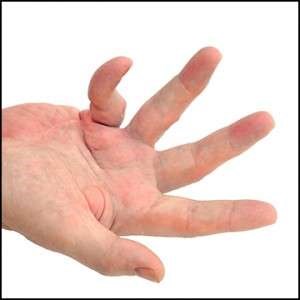Treating Dupuytren’s Contracture Disease with Low-Dose Radiotherapy
Receiving a diagnosis of Dupuytren’s contracture can be confusing, frustrating, and overwhelming. This disease, which causes fingers to curl inward, can make everyday tasks challenging. For some people, the condition may even be painful. While there is no cure for Dupuytren’s contracture, there are many ways to slow or even stop the progression of the disease. Patients can receive injections, undergo surgery, or at Northwest Cancer Clinic, receive radiotherapy treatment for Dupuytren’s contracture.

What Does Dupuytren’s Do?
Dupuytren’s contracture causes the tissue under the skin of the palm to thicken and form nodules or cords. The thickening of tissue is caused by cells called fibroblasts, which form connective tissue. These fibroblasts malfunction and overproduce collagen, resulting in the formation of nodules and tight cords in the hand. These cords can pull the fingers inward, making it hard to straighten them.
How Can Radiotherapy Help Dupuytren’s Contracture?
Radiotherapy treatment for Dupuytren’s contracture uses low doses of radiation to slow down or stop the progression of the contracture by targeting malfunctioning cells and inflammation in the hand.
Radiotherapy reduces the activity of fibroblasts, slowing down the excess production of collagen, which in turn reduces the formation of thickened tissue. Radiotherapy also limits the ability of these cells to multiply. Preventing fibroblasts from increasing in number also helps reduce collagen overproduction. Reducing inflammation is part of reducing the overproduction of cells, and is also key to pain relief if patients are experiencing pain. All of these radiotherapy benefits help slow the progression of the contracture.
Discover how low-dose radiation therapy in Kennewick, WA can help manage Dupuytren’s contracture disease safely and effectively. Schedule your personalized consultation with our experienced radiation specialist today.
What to Expect
The first thing patients can expect when seeking Dupuytren’s radiotherapy treatment options is a consultation with Dr. Juno Choe. Patients typically receive 6-10 treatments spread out over a few weeks, and Dr. Choe will determine the best course of action for treatment. During treatment, patients can sit or lie on a table while a machine directs the low-dose radiation to the hand or hands. Our doctor, Dr. Juno Choe, has over 15 years of experience in radiation oncology and ensures our clinic is at the forefront of radiation technology, so he is very precise and patients can rest assured radiation treatments won’t affect healthy tissue surrounding the area.
Treatment sessions are painless and only last a few minutes. Patients can return to regular activity immediately afterward. Radiotherapy for Dupuytren’s contracture uses lower doses of radiation than radiotherapy for cancers, so it’s much safer with almost no side effects. Patients may experience skin dryness in the treatment area or fatigue, but these are usually short-lived side effects.
Radiotherapy Treatment Outcomes
Dupuytren’s radiotherapy treatment options are not a cure for the contracture, but studies have shown they can significantly slow the progression of the contracture, preventing the formation of thick cords and nodules that can curl the fingers in further. For those who receive treatment early on, radiotherapy treatment for Dupuytren’s contracture has delayed or even prevented the need for surgery later on.
Surgery for Dupuytren’s contracture can be painful and involve long recovery times. Dupuytren’s radiotherapy treatment options are non-invasive, safe, and have proven to be effective in slowing the progression of Dupuytren’s contracture. For patients seeking alternative options to surgery, radiotherapy is a promising alternative.
Why Choose Radiotherapy as Your Dupuytren’s Contracture Treatment?
Radiotherapy is a non-invasive, low-risk option for treating Dupuytren’s contracture disease in its early stages. It helps slow progression, relieve discomfort, and delay the need for surgery. Patients benefit from minimal side effects and no downtime, making it a practical and effective choice.
Benefits of Radiotherapy:
- Targets collagen-producing cells directly
- Reduces inflammation and pain
- Prevents further thickening of hand tissue
- Quick, outpatient sessions with no recovery time
- Helps avoid or delay surgery in many cases
Experience expert oncology radiation therapy in Kennewick, Washington. Our compassionate team delivers advanced, precise treatment options tailored to your condition. Book your consultation with our radiation specialist today.

